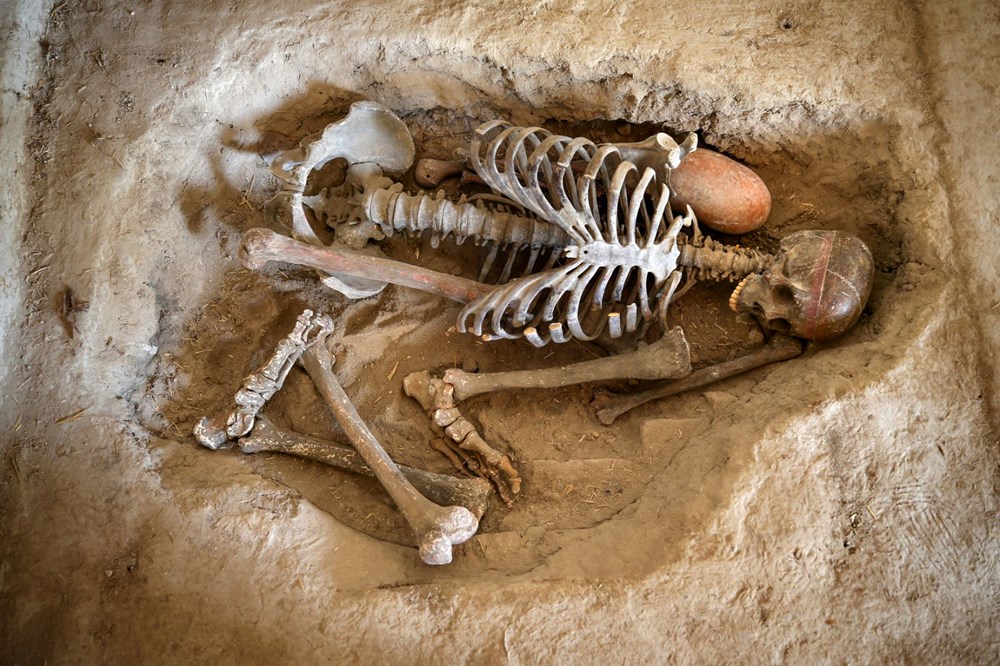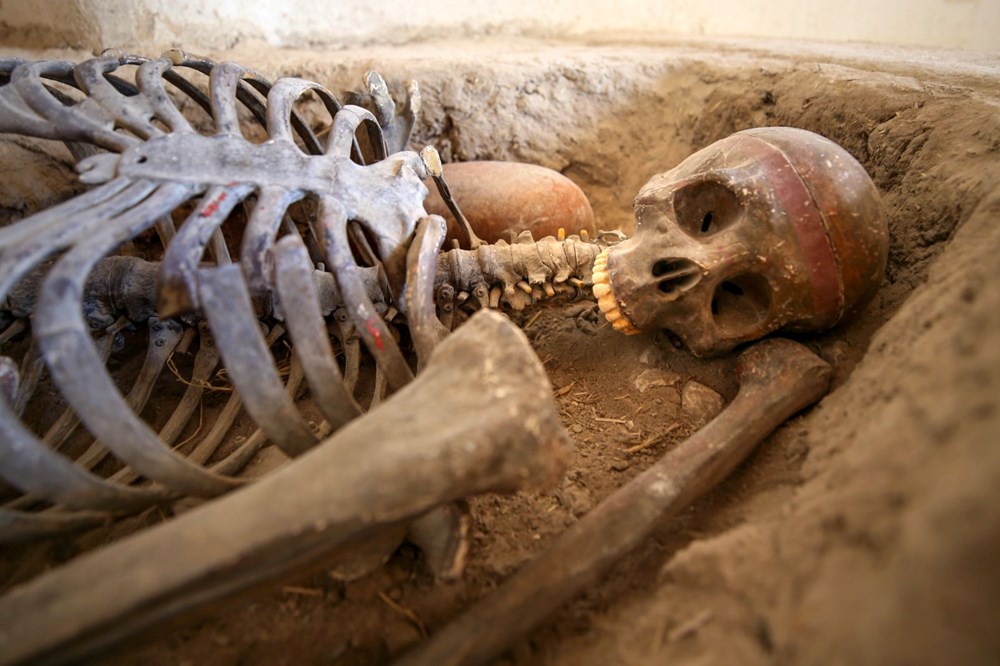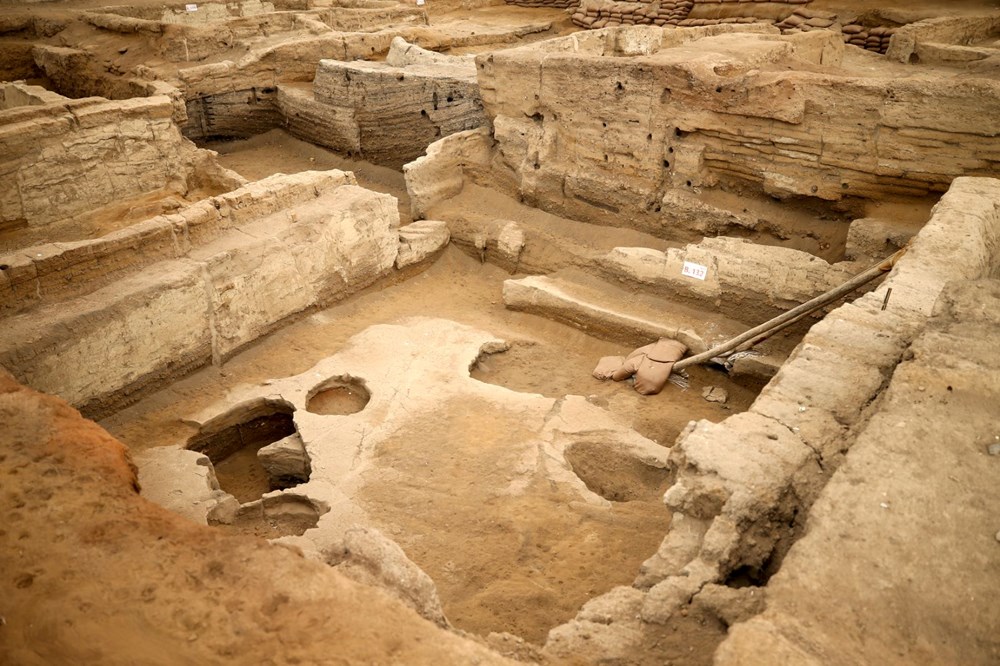In Çatalhöyük, located in Çumra district of Konya, where about 8 thousand people lived together during the Neolithic period, an oven structure was discovered in the area called “Mekan 66”, which is entered from above, where adjacent mudbrick houses are located.
Around the largely destroyed oven, wheat, barley, pea seeds and a palm-sized find that could be food were found.
ANALYSIS STUDIES WERE CARRIED OUT METICULOUSLY
Analyses conducted at Necmettin Erbakan University Science and Technology Research and Application Center (BİTAM) determined that the spongy residue was fermented bread dated to 6600 BC.
Head of the Excavation Committee and Anadolu University Faculty Member Assoc. Prof. Dr. Ali Umut Türkcan told AA correspondent that structures, monuments and finds come to mind when “archaeology” is mentioned.
Pointing out that modern archaeology today also studies the archaeology of food, Türkcan said, “We need to say that the starting point of food archaeology is Anatolia. Çatalhöyük is one of the very important stops here. A finding we discovered in 2021. In Turkish excavations, we have shown that we can now detect such organic remains with very sensitive documentation and detailed studies.”
Stating that Çatalhöyük Neolithic City has an important place in this field, Türkcan said:
“The small, round spongy find in the corner of the oven turned out to be bread after careful documentation. The fact that the structure was covered with a thin layer of clay allowed all of these organic remains, both wood and bread, to be preserved until today. Radio carbon tests conducted at the TUBITAK Marmara Research Center (MAM) showed that our sample can be dated back to approximately 6,600 BC.”

THE WORLD’S OLDEST BREAD
Türkcan explained that the first examples of fermented bread were found in Egypt and used the following expressions:
“We can say that this find at Çatalhöyük is the oldest bread in the world. Considering the observation, analysis and dating of this organic residue, we can say that this bread is approximately 8,600 years old. It is a reduced version of a loaf of bread. It has a finger pressed in the center, it has not been baked, but it has been fermented and has survived to the present day together with the starches inside. There is no such example until today. Çatalhöyük was already the center of many firsts. The world’s first weavings were already in Çatalhöyük when it was excavated. Wooden artifacts were also in Çatalhöyük. Wall paints and paintings were added to this. Konya and Turkey are very lucky in this sense.”
Pointing to the importance of the analysis of the findings, Türkcan said, “It is a great chance to be able to perform all full-fledged analyzes in the laboratories of Necmettin Erbakan University. It was important because it was revealed for the first time in laboratories in Turkey.”

CEREAL REMAINS EXCITE
Salih Kavak, a lecturer at Gaziantep University, who is one of the academics who contributed to the “Çatalhöyük Space 66 Neolithic Period Bread Finds Analysis and Evaluation”, stated that he has been involved in the most exciting work in the field of archaeobotany to date.
Explaining that he was given the news of the organic find while examining plant remains in the laboratory, Kavak said, “I was very surprised when they brought it. Because in this form, I thought, ‘Could it be dough, bread, an organic residue?’ I made a morphological diagnosis with the naked eye, then immediately looked at the content under a microscope. The most exciting thing is that there are cereal remains. The fact that there were ground and broken pieces of plants such as barley, wheat and peas strengthened the possibility of what we immediately thought at first, ‘Is this bread?
“THERE ARE NO FINDS OF THIS BREAD-LIKE FORM FOUND SO FAR”
Kavak stated that chemical and physical analyzes of the find should be carried out afterwards and continued as follows:
“These analyses were necessary to confirm our hypothesis. Prof. Dr. Oğuz Doğan directed us to BİTAM for analysis. In the analysis carried out there, especially in the SEM images, when we looked in detail, air pockets were very evident inside the sample. The presence of seeds and tissue fragments of plants, leaf remains… When we went into more detail, starch grains eliminated our suspicions. When we look at the chemical contents of the other analyses, we see both the presence of chemicals found in plants and indicators of fermentation. Analyses showed that this find was mixed with water and flour and kept for a while, fermented and not cooked. We have seen that it was prepared next to the oven but could not be cooked or baked, in that form. It was an exciting discovery. There are no finds in this form similar to the bread found so far. We call it the oldest bread known at the moment. It is an exciting discovery for Turkey and the world.”

BİTAM Deputy Director Assoc. Prof. Dr. Yasin Ramazan Eker stated that they also analyze archaeological finds at the center and noted the following:
“Since we have advanced technology, analysis and characterization devices at BİTAM, we were able to analyze and identify these samples, especially after determining their chemical and physical structures. Now these samples, which were sent abroad in previous years, remain in Turkey. We can characterize them. We can both interpret them in the field of materials and interpret what the findings mean archaeologically or what richness they have gained. Therefore, there are competent people in Turkey both in the field of archaeology and in the field of characterization.”
Eker added: “We can make these in the central laboratory of Necmettin Erbakan University BİTAM in Konya. One of the most important properties of bread is that when we heat it, its mass is constantly lost. This means that this sample has not seen that temperature before. Since it has not seen that temperature before, we understand that this sample, which is in the form of bread, has not been cooked. Our professors understand it because of its porous, spongy structure. Therefore, we have come to this point with our and their knowledge. It allows us to make a more accurate diagnosis. The sample was suspected to be bread, we confirmed these suspicions.”
Prof. Dr. Oğuz Doğan from Necmettin Erbakan University said that the chemical and physical structures of archaeological samples can be identified at BİTAM.






